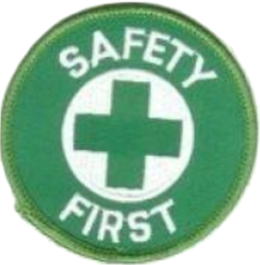Someone sent me a note asking about the latest technology in fighting a tire fire. This appears to be a great resource!
FEM-12 SC®
NEW! FEM-12 SC® reviewed in two leading technical publications
Click here for more information.
The latest agent added to the product line of safety products by the TLI Group for the fire protection industry, changes the way fires can now be safely extinguished. Now high temperature fires can be extinguished in any type of weather. No longer does the fire fighter have to stand within five to eight feet of a high temperature fire in order to extinguish it. The FEM-12 SC® extinguisher allows the fire fighter a range of 30 to 40 feet from the source of the fire. The FEM-12 SC® also presents an agent that is an environmentally safe alternative for the industry. In addition, the fire fighter no longer has to worry about breathing clouds of dust. FEM-12 SC® can now extinguish those high temperature vertical fires safely, and quickly. There is little threat of the material reigniting. Also, the fire fighter no longer has to stand over the fire for over 30 minutes to see if it is going to reignite after applying a dry powder agent. The fire fighter can now move on without worry and extinguish other areas of concern.
Applications include metal fires, such as magnesium and titanium used in aircraft brake assemblies and landing gear components. Other applications include rubber tires, aircraft engines, magnesium rims; and other structural components of the aircraft such as fiber glass, composite materials, and composite materials with honeycomb aluminum.
The extinguishing elements of the FEM-12 SC® work to reduce high temperature fires rapidly, and quickly. It coats the burning material to help in preventing reignition. Because it is a liquid vertical fires can now be successfully fought where previously dry powder was ineffective.
This material has passed the U.S Federal Aviation Administrations testing requirements for aquatic toxicity (American Society for Testing and Materials International – ASTM #E 729-96 reapproved 2002, with range finding test according to the U.S. Environmental Protection Agency; and American National Standards Institute – ANSI/UL 711 Rating and Testing of Fire Extinguishing Section 10.2 and 10.2.28.) These tests where conducted by the United States Air Force Research Laboratory for the U.S. FAA.
For further information go to www.tligroup.com or Google “tn06/26” to see a white paper jointly issued by the United States FAA and the U.S. Air Force Research Laboratory.
Basic EPA Tire Fire Information
Photo of Burning Tires
Tire fires, although infrequent, are serious situations that are difficult to extinguish and expensive to clean-up.
Tire fires often become major hazardous incidents affecting entire communities—frequently requiring neighborhood evacuations and long, drawn-out fire extinguishing operations. These fires threaten pollution of the air, soil, and water. EPA, states, municipalities, and private companies have spent millions of dollars cleaning up tire fires across the country.
EPA does not consider scrap tires a hazardous waste. However, if a tire fire occurs, tires break down into hazardous compounds including gases, heavy metals, and oil. The average passenger car tire is estimated to produce over two gallons of oil when burned. (Source: Rubber Manufacturers Association, April 2003)
Oil that exudes into ground and surface water as a result of tire fires is a significant environment pollutant. In some cases, this may trigger Superfund cleanup status. For every million tires consumed by fire, about 55,000 gallons of runoff oil can pollute the environment unless contained and collected. This oily material is also highly flammable.
Air pollution is also produced by tire fires. Air emissions may include polycyclic aromatic hydrocarbons (PAHs), benzene, styrene, phenols, and butadiene. For more information on toxic air pollutants generated by tire fires, go to EPA’s Toxics Air Pollution website.
Notable Tire Fires
- In 1983, a 7-million tire fire in Rhinehart, Virginia issued a plum of smoke 3,000 feet high and nearly 50 miles long with air pollution emissions deposited in three states. The fire burned for nine months, polluting nearby water sources with lead and arsenic. The tire storage facility where the fire occurred is now being cleaned-up as a Superfund site.
- In 1999, a lightning strike ignited a tire fire in Westley, California. The tire dump contained millions of scrap tires located in a canyon in a coastal mountain range. The large smoke plume from the fire impacted nearby farming communities and caused widespread concern of potential health affects from exposure to the smoke emissions. The tire fire also produced large volumes of pyrolitic oil that flowed off the slope and into the drainage of an intermittent stream. This oil was ignited too and the oil fire significantly increased the smoke emissions close to ground level. A response to the oil and tire fires was beyond the capabilities of local and state agencies. The EPA regional coordinator immediately responded using Oil Pollution Act of 1990 authority. It took 30 days to extinguish the fire. Total EPA response costs were $3.5 million.
Extinguishing Tire Fires
Waste tires are difficult to ignite, but once a tire fire starts, it is generally very hard to control and extinguish. Using water and/or foam to extinguish a tire fire is often futile. Water is best used to keep adjacent, unburned tires from igniting.
Smothering a tire fire with dirt or sand is usually the best option for extinguishing fires. Typically, the sand or dirt is moved with heavy equipment to cover the burning tires.
Putting out a tire fire can also be facilitated by removing unburned tires from the pile to lessen the fuel load.
Additional Information
Through EPA’s Superfund website, users can search for National Priority List sites throughout the US, including those that have resulted from tire fires—such as the Rhinehart Tire Fire Dump Site in Virginia.
Other resources include:




One thought on “Advances in Tire Fires & Extinguishment – New Extinguishing Agent”